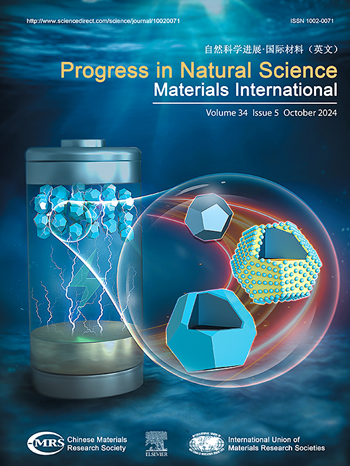Trace Mg2+ doping enhances structural stability of single-crystal layered oxides for sodium-ion batteries
IF 7.1
2区 材料科学
Q2 MATERIALS SCIENCE, MULTIDISCIPLINARY
Progress in Natural Science: Materials International
Pub Date : 2025-06-01
DOI:10.1016/j.pnsc.2025.03.002
引用次数: 0
Abstract
Sodium-ion batteries (SIBs) have emerged as a promising alternative to lithium-ion batteries due to the abundance and low cost of sodium resources. However, the structural instability of P2-type layered oxides during cycling remains a significant challenge, limiting their practical application. Single-crystal materials, with their highly ordered atomic structure and superior electronic and mechanical properties, are pivotal for the development of high-performance SIBs. In this study, we optimize the electrochemical performance of P2-type single-crystal layered oxides by trace doping with Mg2+, carefully preserving the inherent single-crystal structure. Mg2+ doping not only stabilizes the P2 phase and mitigates detrimental phase transitions, but also enhances Na+ diffusion kinetics by subtly expanding the interplanar spacing without disrupting the single-crystal integrity. We demonstrate that trace Mg2+ doping improves the structural and electrochemical properties, resulting in superior cycling stability and rate capability. NMCMg0.05 maintains 83.7 % of its initial capacity after 1000 cycles at 5 C, while full-cell tests with a hard carbon anode show 75.0 % capacity retention after 300 cycles and an energy density of 124.1 Wh·kg−1. This work underscores the critical role of single-crystal engineering and trace doping in enhancing the stability and performance of SIB cathodes, offering a pathway for next-generation, high-performance sodium-ion batteries.
微量Mg2+掺杂提高了钠离子电池单晶层状氧化物的结构稳定性
由于钠资源丰富且成本低,钠离子电池已成为锂离子电池的一个有前途的替代品。然而,p2型层状氧化物在循环过程中的结构不稳定性仍然是一个重大挑战,限制了它们的实际应用。单晶材料具有高度有序的原子结构和优越的电子和机械性能,是高性能sib发展的关键。在本研究中,我们通过微量掺杂Mg2+来优化p2型单晶层状氧化物的电化学性能,同时保持其固有的单晶结构。Mg2+的掺杂不仅稳定了P2相,减轻了有害的相变,而且在不破坏单晶完整性的情况下,通过微妙地扩大面间距,增强了Na+的扩散动力学。我们证明了微量Mg2+掺杂改善了结构和电化学性能,从而获得了优异的循环稳定性和速率能力。在5℃下循环1000次后,NMCMg0.05保持了83.7%的初始容量,而使用硬碳阳极的全电池测试显示,在300次循环后,容量保持率为75.0%,能量密度为124.1 Wh·kg−1。这项工作强调了单晶工程和微量掺杂在提高SIB阴极稳定性和性能方面的关键作用,为下一代高性能钠离子电池提供了途径。
本文章由计算机程序翻译,如有差异,请以英文原文为准。
求助全文
约1分钟内获得全文
求助全文
来源期刊
CiteScore
8.60
自引率
2.10%
发文量
2812
审稿时长
49 days
期刊介绍:
Progress in Natural Science: Materials International provides scientists and engineers throughout the world with a central vehicle for the exchange and dissemination of basic theoretical studies and applied research of advanced materials. The emphasis is placed on original research, both analytical and experimental, which is of permanent interest to engineers and scientists, covering all aspects of new materials and technologies, such as, energy and environmental materials; advanced structural materials; advanced transportation materials, functional and electronic materials; nano-scale and amorphous materials; health and biological materials; materials modeling and simulation; materials characterization; and so on. The latest research achievements and innovative papers in basic theoretical studies and applied research of material science will be carefully selected and promptly reported. Thus, the aim of this Journal is to serve the global materials science and technology community with the latest research findings.
As a service to readers, an international bibliography of recent publications in advanced materials is published bimonthly.

 求助内容:
求助内容: 应助结果提醒方式:
应助结果提醒方式:


